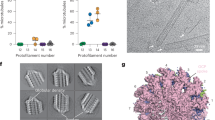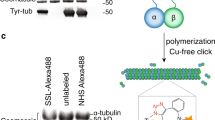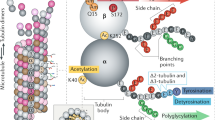Abstract
AMPLE evidence now exists that, in addition to soluble, cytoplasmic tubulin, many tissues contain variable proportions of particulate tubulin as judged from colchicine-binding studies1–6. This colchicine-binding activity is not contamination from cytoplasmic microtubules, and is associated with a fraction enriched in plasma membrane markers6. The activity exhibits the ligand-binding properties of purified tubulin and reacts with antibodies against soluble brain tubulin. Finally, when the binding activity is solubilised from membranes it exhibits normal binding behaviour toward antimitotic agents, normal thermal lability, and normal interaction with antibody6. What was not clear was whether this tubulin could participate in polymerisation reactions to form microtubules. We report here that solubilised, labelled tubulin copolymerises with cytoplasmic tubulin through repeated cycles of polymerisation and depolymerisation.
This is a preview of subscription content, access via your institution
Access options
Subscribe to this journal
Receive 51 print issues and online access
$199.00 per year
only $3.90 per issue
Buy this article
- Purchase on Springer Link
- Instant access to full article PDF
Prices may be subject to local taxes which are calculated during checkout
Similar content being viewed by others
References
Dahl, R., Redburn, D., and Samson, F. E., Jr, J. Neurochem., 17, 1215–1219 (1970).
Feit, H., and Barondes, S., J. Neurochem., 17, 1355–1364 (1970).
Wilson, L., Biochemistry, 9, 4999–5007 (1970).
Lagnado, J. R., Lyons, C., and Wickremasinghe, G., FEBS Lett., 15, 254–258 (1971).
Stadler, J., and Franke, W. W., Nature new Biol., 237, 237–238 (1972).
Bhattacharyya, B., and Wolff, J., J. biol. Chem., 250, 7639–7649 (1975).
Shelanski, M. L., Gaskin, F., and Cantor, C. R., Proc. natn. Acad. Sci. U.S.A., 70, 765–768 (1973).
Weber, K., and Osborne, M., J. biol. Chem., 244, 4406–4412 (1969).
Franke, W. W., Herth, W., Vanderwoude, J., and Movie, D. J., Planta, 105, 317 (1972).
Roberts, K., Prog. Biophys. molec. Biol., 28, 371–420 (1974).
Bird, M. M., Cell Tissue Res., 168, 101–155 (1976).
Ukena, T. E., and Berlin, R. D., J. exp. Med., 136, 1–7 (1972).
Edelman, G. M., Tahara, I., and Wang, J. L., Proc. natn. Acad. Sci. U.S.A., 70, 1442–1446 (1973).
Nicolson, G. L., Biochim. biophys. Acta, 457, 57–108 (1976).
Becker, J. S., Oliver, J. M., and Berlin, R. D., Nature, 254, 152–154 (1975).
Author information
Authors and Affiliations
Rights and permissions
About this article
Cite this article
BHATTACHARYYA, B., WOLFF, J. Polymerisation of membrane tubulin. Nature 264, 576–577 (1976). https://doi.org/10.1038/264576a0
Received:
Accepted:
Published:
Issue Date:
DOI: https://doi.org/10.1038/264576a0
This article is cited by
-
JWA, a novel microtubule-associated protein, regulates homeostasis of intracellular amino acids in PC12 cells
Chinese Science Bulletin (2003)
-
Taxol-induced neuropathy after nerve crush: long-term effects on regenerating axons
Acta Neuropathologica (1990)
-
Interaction of the cytoskeleton with the plasma membrane
The Journal of Membrane Biology (1987)
-
Loss of microtubules and alteration of glycoprotein migration in organ cultures of mouse intestine exposed to nocodazole or colchicine
Cell and Tissue Research (1987)
-
The ATPase activity in brain microtubule preparations is membrane-associated
Histochemistry (1983)
Comments
By submitting a comment you agree to abide by our Terms and Community Guidelines. If you find something abusive or that does not comply with our terms or guidelines please flag it as inappropriate.



